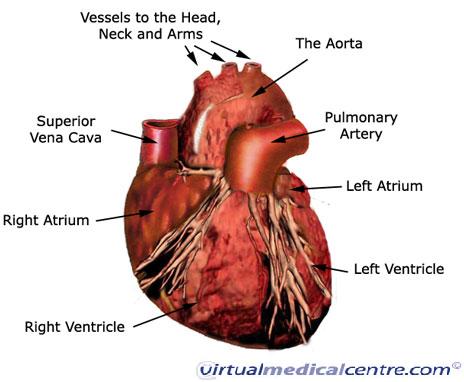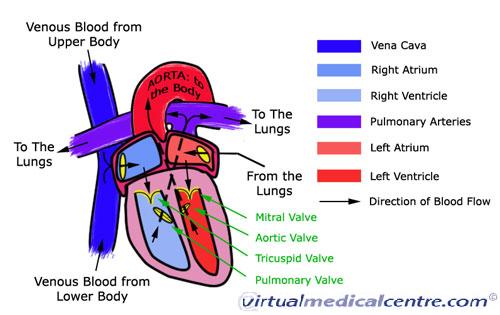CARDIOVASCULAR SYSTEM
The cardiovascular system can be thought of as the transport system of the body. This system has three main components: the heart, the blood vessel and the blood itself. The heart is the system’s pump and the blood vessels are like the delivery routes. Blood can be thought of as a fluid which contains the oxygen and nutrients the body needs and carries the wastes which need to be removed. The following information describes the structure and function of the heart and the cardiovascular system as a whole.

THE STRUCTURE AND FUNCTION OF THE HEART
The heart’s job is to pump blood around the body. The heart is located in between the two lungs. It lies left of the middle of the chest.
Structure of the Heart
The heart is a muscle about the size of a fist, and is roughly cone-shaped. It is about 12cm long, 9cm across the broadest point and about 6cm thick. The pericardium is a fibrous covering which wraps around the whole heart. It holds the heart in place but allows it to move as it beats. The wall of the heart itself is made up of a special type of muscle called cardiac muscle.
Chambers of the Heart
The heart has two sides, the right side and the left side. The heart has four chambers. The left and right side each have two chambers, a top chamber and a bottom chamber. The two top chambers are known as the left and right (singular: atrium). The atria receive blood from different sources. The left atrium receives blood from the lungs and the right atrium receives blood from the rest of the body. The bottom two chambers are known as the left and right ventricles. The ventricles pump blood out to different parts of the body. The right ventricle pumps blood to the lungs while the left ventricle pumps out blood to the rest of the body. The ventricles have much thicker walls than the atria which allows them to perform more work by pumping out blood to the whole body.
Blood Vessels
Blood Vessel are tubes which carry blood. Veins are blood vessels which carry blood from the body back to the heart. Artries are blood vessels which carry blood from the heart to the body. There are also microscopic blood vessels which connect arteries and veins together called caplliries. There are a few main blood vessels which connect to different chambers of the heart. The aorta is the largest artery in our body. The left ventricle pumps blood into the aorta which then carries it to the rest of the body through smaller arteries. The pulmonary trunk is the large artery which the right ventricle pumps into. It splits into pulmonary arteries which take the blood to the lungs. The pulmonary veins take blood from the lungs to the left atrium. All the other veins in our body drain into the inferior vens cava(IVC) or the superior vena cava(SVC) . These two large veins then take the blood from the rest of the body into the right atrium.
Valves
Valves are fibrous flaps of tissue found between the heart chambers and in the blood vessels. They are rather like gates which prevent blood from flowing in the wrong direction. They are found in a number of places. Valves between the atria and ventricles are known as the right and left atriventricular valves, otherwise known as the tricuspid and mitral valves respectively. Valves between the ventricles and the great arteries are known as the semilunar valves. The aortic valve is found at the base of the aorta, while the pulmonary valve is found the base of the pulmonary trunk. There are also many valves found in veins throughout the body. However, there are no valves found in any of the other arteries besides the aorta and pulmonary trunk.
What is the Cardiovascular System?
The cardiovascular system refers to the heart, blood vessels and the blood. Blood contains oxygen and other nutrients which your body needs to survive. The body takes these essential nutrients from the blood. At the same time, the body dumps waste products like carbon dioxide, back into the blood, so they can be removed. The main function of the cardiovascular system is therefore to maintain blood flow to all parts of the body, to allow it to survive. Veins deliver used blood from the body back to the heart. Blood in the veins is low in oxygen (as it has been taken out by the body) and high in carbon dioxide (as the body has unloaded it back into the blood). All the veins drain into the superior and inferior vena cava which then drain into the right atrium. The right atrium pumps blood into the right ventricle. Then the right ventricle pumps blood to the pulmonary trunk, through the pulmonary arteries and into the lungs. In the lungs the blood picks up oxygen that we breathe in and gets rid of carbon dioxide, which we breathe out. The blood is becomes rich in oxygen which the body can use. From the lungs, blood drains into the left atrium and is then pumped into the left ventricle. The left ventricle then pumps this oxygen-rich blood out into the aorta which then distributes it to the rest of the body through other arteries. The main arteries which branch off the aorta and take blood to specific parts of the body are:
- Carotid artries, which take blood to the neck and head
- Coronary arteriies, which provide blood supply to the heart itself
- Hepatic artery, which takes blood to the liver with branches going to the stomach
- Mesenteric artery, which takes blood to the intestines
- Renal arteries, which takes blood to the kidneys
- Femoral arteries, which take blood to the legs
The body is then able to use the oxygen in the blood to carry out its normal functions. This blood will again return back to the heart through the veins and the cycle continues

What is the Cardiac Cycle?
The cardiac cycle is the sequence of events that occurs in one complete beat of the heart . The pumping phase of the cycle, also known as systole, occurs when heart muscle contracts. The filling phase, which is known as diastole, occurs when heart muscle relaxes. At the beginning of the cardiac cycle, both atria and ventricles are in diastole. During this time, all the chambers of the heart are relaxed and receive blood. The atrioventricular valves are open. Artial systole follows this phase. During atrial systole, the left and right atria contract at the same time and push blood into the left and right ventricles, respectively. The next phase is ventricular systole. During ventricular systole, the left and right ventricles contract at the same time and pump blood into the aorta and pulmonary trunk, respectively. In ventricular systole, the atria are relaxed and receive blood. The atrioventricular valves close immediately after ventricular systole begins to stop blood going back into the atria. However, the semilunar valves are open during this phase to allow the blood to flow into the aorta and pulmonary trunk. Following this phase, the ventricles relax that is ventricular diastole occurs. The semilunar valves close to stop the blood from flowing back into the ventricles from the aorta and pulmonary trunk. The atria and ventricles once again are in diastole together and the cycle begins again.
Components of the Heartbeat
The adult heart beats around 70 to 80 times a minute at rest. When you listen to your heart with a stethoscope you can hear your heart beat. The sound is usually described as “lubb-dupp”. The “lubb” also known as the first heart sound, is caused by the closure of the atrioventricular valves. The “dupp” sound is due to the closure of the semilunar valves when the ventricles relax (at the beginning of ventricular diastole). Abnormal heart sounds are known as murmurs. Murmurs may indicate a problem with the heart valves, but many types of murmur are no cause for concern.
The Electrocardiogram
The heart has an inbuilt rhythm of contraction and relaxation. A small group of heart muscle cells called the pacemaker help achieve this. The pacemaker generates an electrical impulse which spreads over the atria, making them contract. This impulse then spreads to the ventricles, causing them to contract. The electrical changes that spread through the heart can be detected at the surface of the body by an instrument called the electrocardiograph. Electrodes are placed in a number of positions over the chest and the electrical changes are recorded on moving graph paper as an electrocardiogram (ECG).
Effects of Aging on the Heart in Men and Women
As a part of the normal aging process a number of changes occur to the cardiovascular system.
- Our heart rate slows down because the time between heartbeats increases as we age. This is one of the main reasons why the heart is unable to pump out more blood during exercise when we become old.
- The amount of blood the heart pumps each minute can change as we age. It decreases slightly in older women. However, it does not change in healthy older men who have no heart disease. The reason for the difference between the sexes is not fully understood.
- As we age, our blood pressure falls much more on standing from the sitting position compared to when we are younger. This phenomenon is known as postural hypotension. This explains why elderly people are more likely to feel dizzy or to fall when they stand up quickly from a resting position.
References
- Guyton, A and Hall, J. (editors) Textbook of medical physiology. Philadelphia, W. B. Saunders, 2000.
- Johnson, L. (editor) Essential medical physiology. Philadelphia, Lippincott-Raven, 1998.
- Saladin, K. Anatomy & physiology: the unity of form and function. Boston, McGraw-Hill, 2001.
- Talley, N and O’Connor, S. Clinical examination: a guide to physical diagnosis. Sydney, MacLennan & Petty, 2001.
After the end of the course, students will be able to learn about:
- The working of Heart as pump.
- The Rhythmical excitation of the Heart.
- The Normal ECG.
- The Cardiac Arrhythmias.
- Overview of the Circulation.
- The Vascular distensibility and the function of Arterial and Venous system.
- The Microcirculation and Lymphatic system.
- Local control of Blood flow.
- Nervous regulation of Circulation.
- Arterial pressure and its regulation.
- Cardiac output and Venous returns and their regulation.
- Cardiac failure.
- Heart Sounds, Congenital Heart defects, Valvular Heart dieseases.
- Circulatory shock.
Assessment Criteria:
Assessment schedule: 4 tests & one send-up written examination including objective & subjective (SEQs, LEQs) type questions
Internal Assessment (based on class tests, class performance and attendance): 10 Marks
Written: 90 Marks
Practical: 00 Marks


